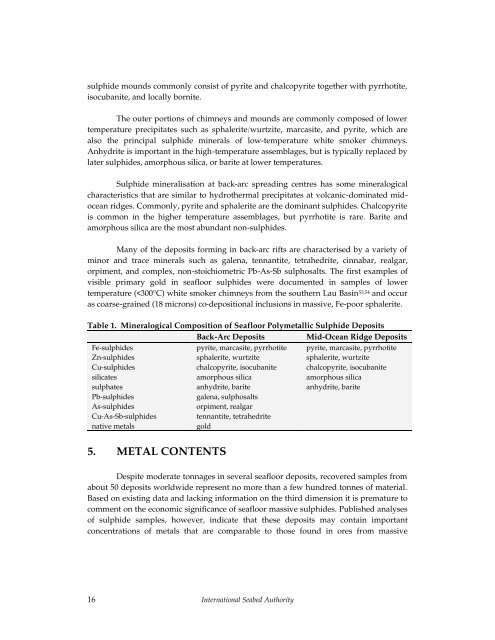Full page fax print - International Seabed Authority
Full page fax print - International Seabed Authority
Full page fax print - International Seabed Authority
You also want an ePaper? Increase the reach of your titles
YUMPU automatically turns print PDFs into web optimized ePapers that Google loves.
sulphide mounds commonly consist of pyrite and chalcopyrite together with pyrrhotite,<br />
isocubanite, and locally bornite.<br />
The outer portions of chimneys and mounds are commonly composed of lower<br />
temperature precipitates such as sphalerite/wurtzite, marcasite, and pyrite, which are<br />
also the principal sulphide minerals of low-temperature white smoker chimneys.<br />
Anhydrite is important in the high-temperature assemblages, but is typically replaced by<br />
later sulphides, amorphous silica, or barite at lower temperatures.<br />
Sulphide mineralisation at back-arc spreading centres has some mineralogical<br />
characteristics that are similar to hydrothermal precipitates at volcanic-dominated midocean<br />
ridges. Commonly, pyrite and sphalerite are the dominant sulphides. Chalcopyrite<br />
is common in the higher temperature assemblages, but pyrrhotite is rare. Barite and<br />
amorphous silica are the most abundant non-sulphides.<br />
Many of the deposits forming in back-arc rifts are characterised by a variety of<br />
minor and trace minerals such as galena, tennantite, tetrahedrite, cinnabar, realgar,<br />
orpiment, and complex, non-stoichiometric Pb-As-Sb sulphosalts. The first examples of<br />
visible primary gold in seafloor sulphides were documented in samples of lower<br />
temperature (

















